CDK1 and CCNA2 play important roles in oral squamous cell carcinoma
- PMID: 38640322
- PMCID: PMC11029925
- DOI: 10.1097/MD.0000000000037831
CDK1 and CCNA2 play important roles in oral squamous cell carcinoma
Abstract
Oral squamous cell carcinoma (OSCC) is a malignant tumor that occurs in oral cavity and is dominated by squamous cells. The relationship between CDK1, CCNA2, and OSCC is still unclear. The OSCC datasets GSE74530 and GSE85195 configuration files were downloaded from the Gene Expression Omnibus (GEO) database and were derived from platforms GPL570 and GPL6480. Differentially expressed genes (DEGs) were screened. The weighted gene co-expression network analysis, functional enrichment analysis, gene set enrichment analysis, construction and analysis of protein-protein interaction (PPI) network, Comparative Toxicogenomics Database analysis were performed. Gene expression heatmap was drawn. TargetScan was used to screen miRNAs that regulate central DEGs. A total of 1756 DEGs were identified. According to Gene Ontology (GO) analysis, they were predominantly enriched in processes related to organic acid catabolic metabolism, centromeric, and chromosomal region condensation, and oxidoreductase activity. In Kyoto Encyclopedia of Genes and Genomes (KEGG) analysis, the DEGs were mainly concentrated in metabolic pathways, P53 signaling pathway, and PPAR signaling pathway. Weighted gene co-expression network analysis was performed with a soft-thresholding power set at 9, leading to the identification of 6 core genes (BUB1B, CCNB1, KIF20A, CCNA2, CDCA8, CDK1). The gene expression heatmap revealed that core genes (CDK1, CCNA2) were highly expressed in OSCC samples. Comparative Toxicogenomics Database analysis demonstrated associations between the 6 genes (BUB1B, CCNB1, KIF20A, CCNA2, CDCA8, CDK1) and oral tumors, precancerous lesions, inflammation, immune system disorders, and tongue tumors. The associated miRNAs for CDK1 gene were hsa-miR-203a-3p.2, while for CCNA2 gene, they were hsa-miR-6766-3p, hsa-miR-4782-3p, and hsa-miR-219a-5p. CDK1 and CCNA2 are highly expressed in OSCC. The higher the expression of CDK1 and CCNA2, the worse the prognosis.
Copyright © 2024 the Author(s). Published by Wolters Kluwer Health, Inc.
Conflict of interest statement
The authors have no conflicts of interest to disclose.
Figures

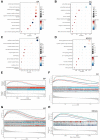
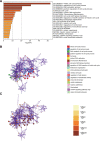

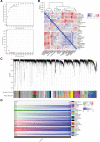

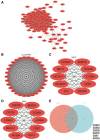
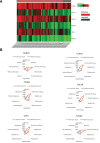
Similar articles
-
Construction of the miRNA-mRNA regulatory network and analysis of hub genes in oral squamous cell carcinoma.Biomed Pap Med Fac Univ Palacky Olomouc Czech Repub. 2022 Sep;166(3):280-289. doi: 10.5507/bp.2022.001. Epub 2022 Feb 3. Biomed Pap Med Fac Univ Palacky Olomouc Czech Repub. 2022. PMID: 35132271
-
Integrated Bioinformatics Analysis of mRNAs and miRNAs Identified Potential Biomarkers of Oral Squamous Cell Carcinoma.Asian Pac J Cancer Prev. 2020 Jun 29;21(6):1841-1848. doi: 10.31557/APJCP.2020.21.6.1841. Asian Pac J Cancer Prev. 2020. PMID: 32597160 Free PMC article.
-
Effect of COL11A1 on oral squamous cell carcinoma.J Stomatol Oral Maxillofac Surg. 2025 Jun;126(3S):102183. doi: 10.1016/j.jormas.2024.102183. Epub 2024 Dec 3. J Stomatol Oral Maxillofac Surg. 2025. PMID: 39631528
-
Mechanism of Astragaloside-Brucea javanica oil nanoemulsion against oral squamous cell carcinoma through CDK1/MTFR2: Network pharmacology, bioinformatics, and experimental studies.PLoS One. 2025 Aug 1;20(8):e0329622. doi: 10.1371/journal.pone.0329622. eCollection 2025. PLoS One. 2025. PMID: 40748969 Free PMC article.
-
Common gene signatures and key pathways in hypopharyngeal and esophageal squamous cell carcinoma: Evidence from bioinformatic analysis.Medicine (Baltimore). 2020 Oct 16;99(42):e22434. doi: 10.1097/MD.0000000000022434. Medicine (Baltimore). 2020. PMID: 33080677 Free PMC article.
Cited by
-
Identification of benzo(a)pyrene-related toxicological targets and their role in chronic obstructive pulmonary disease pathogenesis: a comprehensive bioinformatics and machine learning approach.BMC Pharmacol Toxicol. 2025 Feb 17;26(1):33. doi: 10.1186/s40360-025-00842-1. BMC Pharmacol Toxicol. 2025. PMID: 39962573 Free PMC article.
-
Exploring potential key genes and pathways associatedwith hepatocellular carcinoma prognosis through bioinformatics analysis, followed by experimental validation.Am J Transl Res. 2024 Dec 15;16(12):7286-7302. doi: 10.62347/WIER4743. eCollection 2024. Am J Transl Res. 2024. PMID: 39822558 Free PMC article.
-
[Expression and its clinical significance of cell-cycle dependent kinase 1 in malignant peripheral nerve sheath tumors].Zhongguo Xiu Fu Chong Jian Wai Ke Za Zhi. 2024 Oct 15;38(10):1220-1228. doi: 10.7507/1002-1892.202406090. Zhongguo Xiu Fu Chong Jian Wai Ke Za Zhi. 2024. PMID: 39433496 Free PMC article. Chinese.
-
Identification and Validation of Telomere-Related Gene Signature in Intervertebral Disc Degeneration.Cureus. 2024 Oct 17;16(10):e71735. doi: 10.7759/cureus.71735. eCollection 2024 Oct. Cureus. 2024. PMID: 39553152 Free PMC article.
References
-
- Chamoli A, Gosavi AS, Shirwadkar UP, et al. . Overview of oral cavity squamous cell carcinoma: risk factors, mechanisms, and diagnostics. Oral Oncol. 2021;121:105451. - PubMed
-
- Saalim M, Sansare K, Karjodkar FR, et al. . The prevalence of oral squamous cell carcinoma with oral submucous fibrosis. J Cancer Res Ther. 2021;17:1510–4. - PubMed
-
- Vitório JG, Duarte-Andrade FF, Dos Santos Fontes Pereira T, et al. . Metabolic landscape of oral squamous cell carcinoma. Metabolomics. 2020;16:105. - PubMed
-
- McCord C, Kiss A, Magalhaes MA, et al. . Oral squamous cell carcinoma associated with precursor lesions. Cancer Prev Res (Phila). 2021;14:873–84. - PubMed
MeSH terms
Substances
LinkOut - more resources
Full Text Sources
Medical
Molecular Biology Databases
Research Materials
Miscellaneous

